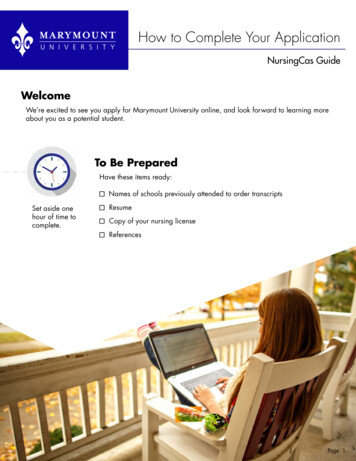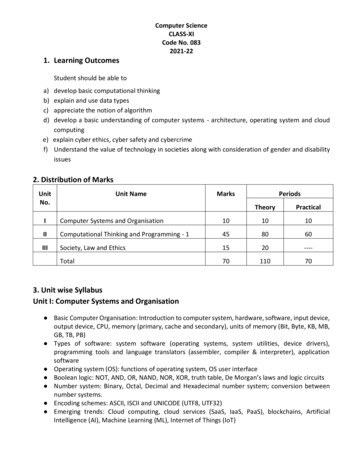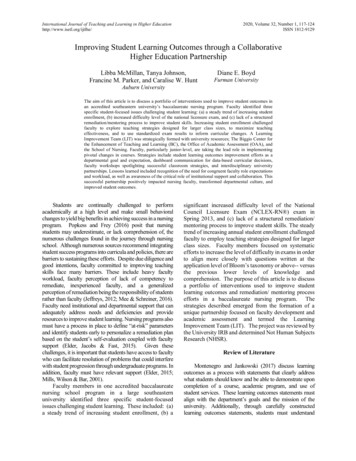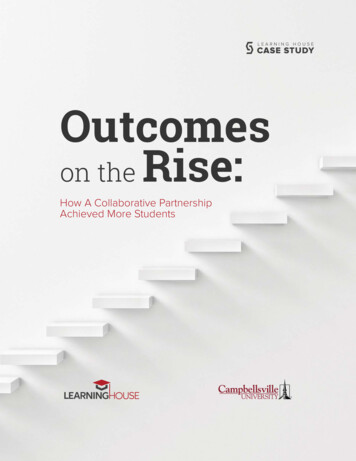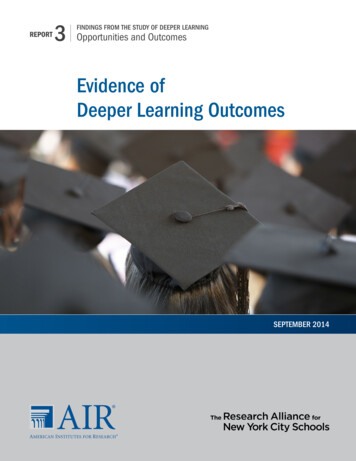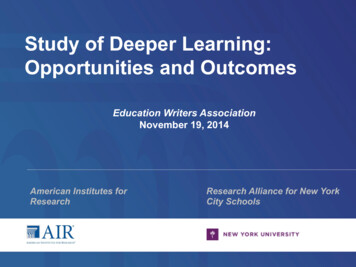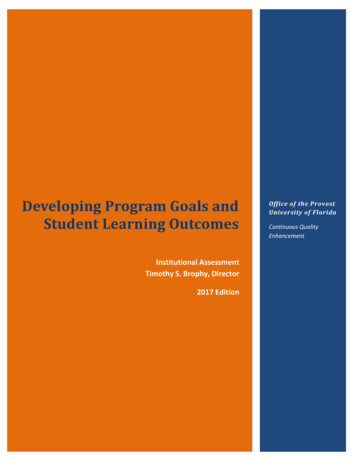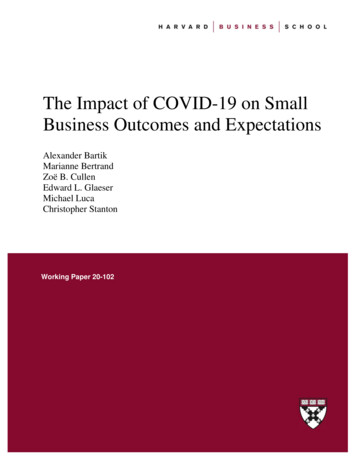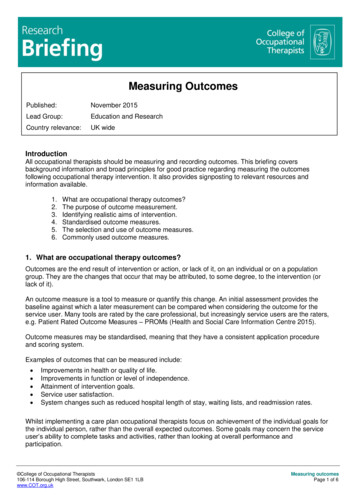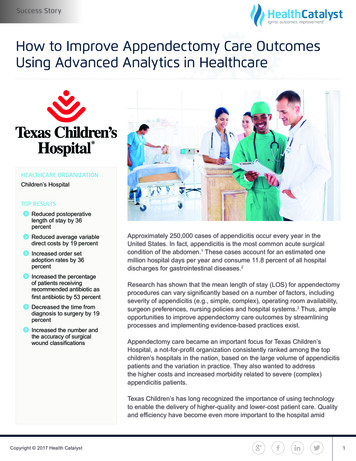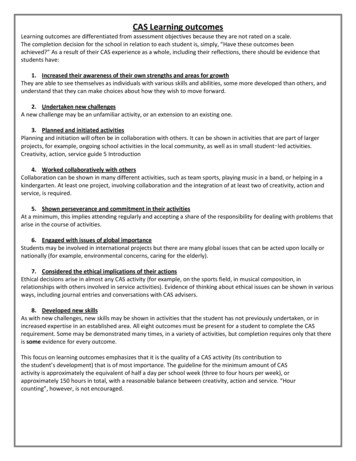
Transcription
CAS Learning outcomesLearning outcomes are differentiated from assessment objectives because they are not rated on a scale.The completion decision for the school in relation to each student is, simply, “Have these outcomes beenachieved?” As a result of their CAS experience as a whole, including their reflections, there should be evidence thatstudents have:1. Increased their awareness of their own strengths and areas for growthThey are able to see themselves as individuals with various skills and abilities, some more developed than others, andunderstand that they can make choices about how they wish to move forward.2. Undertaken new challengesA new challenge may be an unfamiliar activity, or an extension to an existing one.3. Planned and initiated activitiesPlanning and initiation will often be in collaboration with others. It can be shown in activities that are part of largerprojects, for example, ongoing school activities in the local community, as well as in small student‑led activities.Creativity, action, service guide 5 Introduction4. Worked collaboratively with othersCollaboration can be shown in many different activities, such as team sports, playing music in a band, or helping in akindergarten. At least one project, involving collaboration and the integration of at least two of creativity, action andservice, is required.5. Shown perseverance and commitment in their activitiesAt a minimum, this implies attending regularly and accepting a share of the responsibility for dealing with problems thatarise in the course of activities.6. Engaged with issues of global importanceStudents may be involved in international projects but there are many global issues that can be acted upon locally ornationally (for example, environmental concerns, caring for the elderly).7. Considered the ethical implications of their actionsEthical decisions arise in almost any CAS activity (for example, on the sports field, in musical composition, inrelationships with others involved in service activities). Evidence of thinking about ethical issues can be shown in variousways, including journal entries and conversations with CAS advisers.8. Developed new skillsAs with new challenges, new skills may be shown in activities that the student has not previously undertaken, or inincreased expertise in an established area. All eight outcomes must be present for a student to complete the CASrequirement. Some may be demonstrated many times, in a variety of activities, but completion requires only that thereis some evidence for every outcome.This focus on learning outcomes emphasizes that it is the quality of a CAS activity (its contribution tothe student’s development) that is of most importance. The guideline for the minimum amount of CASactivity is approximately the equivalent of half a day per school week (three to four hours per week), orapproximately 150 hours in total, with a reasonable balance between creativity, action and service. “Hourcounting”, however, is not encouraged.
Reflection, recording and reportingReflection needs to be developed. It should not be assumed that it comes naturally. Just as the kind of reflection that acritic applies to a work of art or literature is something that develops with time and experience, so the kind of reflectionappropriate in CAS is something that requires guidance and practice. The fundamentals are simple. Of any activity, it isappropriate to ask the following questions. What did I plan to do? What did I do? What were the outcomes, for me, the team I was working with, and others?The difficulty lies in the complexity of the possible answers.Kinds of reflectionDifferent kinds of reflection work for different people. Reflection can be: Public or private Individual or shared Objective or subjective.For example, in a CAS group project, the planning stages are largely public, so reflection on them can be largely public,shared and objective. The term “largely” is used because there may be individual views that arise independently, interms of how satisfactory the process was for a particular student (who may enter and leave the activity with differentpersonal experiences from others). Carrying out the project is likely to be both public and private, both individual andshared, and both objective and subjective.Outcomes of a project or other activity are similar: there may be objective successes and limitations of theactivity as a whole, but what it has meant for the team and for individuals within it may be more varied. Creativity,action, service guide Details.For some students and some kinds of reflection (such as private, individual, subjective), writing is the best tool forreflection. However, for many, reflective writing does not come naturally. It can, to some extent, be “modeled” in oraldiscussion of more public, less sensitive matters, either as an end in itself or as a preludeto writing. But writing is by no means the only possible outcome of reflection. Students can present their activities
orally to peers, parents or outsiders. They can make scrapbooks, photo essays, videos/DVDs or weblogs. They can usejournals or make up varied portfolios. Or they may sometimes simply reflect privately: some of the most importantlessons may be very personal ones that students should be allowed to keep to themselves.Developing reflectionMoving on from the “What ?” questions outlined earlier, experiential learners might consider, where appropriate, forthemselves and others, and for each stage of an activity (before, during and after): how they felt what they perceived what they thought about the activity what the activity meant to them what the value of the activity was what they learned from the activity and how this learning (for example, a change of perspective)might apply more widely. There are many different sources of advice on techniques for developing reflection, somemore appropriate to CAS than others. Reed and Koliba (1995) and Berger Kaye (2004) have many useful ideas.Recording and reportingStudents should document their CAS activities, noting in particular their reflections upon their experiences. As previouslyindicated, this documentation may take many forms, including weblogs, illustrated displays and videos, and writtennotes. Its extent should match the significance of the particular activity to the student. While it is important toencourage students to make an early start on their CAS log, there is no point in writing lengthy accounts about relativelyroutine experiences. Some of the most valuable recording and reporting happens when there is a real audience andpurpose, for example, when students inform other students, parents or the wider community about what is planned orwhat has been achieved.There should be consultations between each student and a CAS adviser as necessary, at least twice in year 1 and once inyear 2, where the student’s progress is discussed and appropriate encouragement and advice is given. Theseconsultations should be briefly documented on a simple CAS progress form. If any concerns arise, especially aboutwhether a student will successfully complete the CAS requirement, these should be noted and appropriate action shouldbe taken at the earliest opportunity. The school will record the completion decision for each student, noting theevidence for each learning outcome. This decision is reported to the regional office, as specified in the Handbook ofprocedures for the Diploma Programme.Creativity, action, service guide 11DetailsWhere a school is required to submit sample student CAS records to the regional office, as part of the regular monitoringprocess, the records required will be: the progress form (see model form A in the “Appendices” for a possible model) the completion form (see model form B in the “Appendices” for a possible model) up to 10 sample pages from the student’s ongoing documentation. These sample pages, which may, for example, bephotocopied journal pages or printouts from electronic logs, must include a list of the principal activities undertaken andevidence of both planning and reflection. For one or more activities, it must be possible for the reader to tell whathappened, why it happened, how it happened, what its value was and what the student learned from it. Schools shouldretain other supporting material until 31 May (May session schools) or 30 November (November session schools) in casethere are queries about the material supplied. As part of routine monitoring, or during five‑year reviews, regionaloffices may request to see the complete documentation for individual students.Range and diversity of activitiesAll students should be involved in CAS activities that they have initiated themselves. Other CAS activities may beinitiated by the school. Activities should vary in length and in the amount of commitment required from the student, butnone should be trivial. Some schools have ongoing relationships with local organizations that offer challengingopportunities for service activities that may also incorporate elements of creativity and/or action. Other schoolsundertake major, concentrated, one‑off activities that may involve considerable planning and fund‑raising (for example,expeditions or building projects).
The Online Curriculum Centre (OCC) is a good place to look for examples of varied CAS activities, large and small. A briefvisit to this extensive website can begin to give a sense of how individual schools tailor their CAS programmes accordingto the constraints and opportunities of their own situations. In line with the aim of CAS to broaden students’ experienceduring their Diploma Programme years, work that is part of a student’s study of a Diploma Programme subject, theory ofknowledge or extended essay may not be counted towards CAS. This excludes, for example, routine practice performedby IB music or dance students. However, where students undertake activities that follow CAS guidelines (for example, bymeeting CAS learning outcomes and including student initiative or choice), the fact that these activities also satisfy therequirements of a state qualification or of another award scheme does not prevent them from being counted towardsCAS. The idea of CAS is to ensure that students have a balanced, fulfilling overall experience; it is not to overloadstudents who are already participating in a very demanding academic schedule.Projects, themes, conceptsStudents should be involved in at least one project involving teamwork that integrates two or more of creativity, actionand service, and is of significant duration. Larger scale activities of this sort may provide excellent opportunities forstudents to engage “with issues of global importance”. From time to time, in line with its mission statement, the IB mayidentify broad themes that schools are invited to support (“Sharing our humanity” is the first of these). Such themes mayprovide a context that will enable students to generalize further in their reflections, following the maxim “Think globally,act locally”. Creativity, a 12 action, service guide DetailsOther possible sources of organizing themes or concepts, which schools may wish to consult, include the United Nations’Millennium Development Goals (www.un.org/millenniumgoals/) and various websites dealing with global issues (enter“global issues” in a search engine). As with any Internet sources, some of these websites are more reputable and/orcredible than others. Many schools have also found inspiration in JF Rischard’s twenty global problems (see Rischard2002).CreativityCreative activities should have a definite goal or outcome. They should be planned and evaluated like all CAS activities.This can present something of a challenge where, for example, a student is a dedicated instrumental musician. It wouldbe artificial to rule that something that is both a pleasure and a passion for the student could not be considered part oftheir CAS experience. How, though, can it help to fulfill CAS learning outcomes? It may be useful to refer back to thesection “The nature of creativity, action, service”, particularly to the second principle: personal challenge—tasks mustextend the student and be achievable in scope.Perhaps the instrumental musician can learn a particularly difficult piece, or a different style of playing, in order toperform for an audience. The context might be a fund‑raising activity, or the student might give a talk to youngerchildren about the instrument, with musical illustrations. Appropriate CAS activities are not merely “more of thesame”—more practice, more concerts with the school band, and so on. This excludes, for example, routine practiceperformed by IB music or dance students (as noted earlier), but does not exclude music, dance or art activities thatthese students are involved with outside the Diploma Programme subject coursework.ActionSimilar considerations apply here. An outstanding athlete will not stop training and practicing in order to engage in somearbitrary, invented CAS physical activity. However, modern approaches to sports coaching emphasize the notion of thereflective practitioner, so it is possible for the athletics coach to incorporate relevant CAS principles and practice intotraining schedules for the benefit of the student. Setting goals, and planning and reflecting on their achievement, is vital.“Extending” the student may go further, for example, to asking them to pass on some of their skills and knowledge toothers. If their chosen sport is entirely individual, perhaps they should try a team game, in order to experience thedifferent pleasures and rewards on offer.Some excellent “action” activities are not sporting or competitive but involve physical challenge by demandingendurance (such as long‑distance trekking) or the conquest of personal fears (for example, rock climbing). It isimportant that schools carefully assess the risks involved in such activities. Alternatively, a student’s “action” may bephy
However, for many, reflective writing does not come naturally. It can, to some extent, be “modeled” in oral discussion of more public, less sensitive matters, either as an end in itself or as a prelude to writing. But writing is by no means the only possible outcome of reflection. Students can present their activities . orally to peers, parents or outsiders. They can make scrapbooks, photo .
